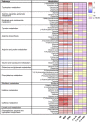Inside the Alterations of Circulating Metabolome in Antarctica: The Adaptation to Chronic Hypoxia
- PMID: 35145434
- PMCID: PMC8821919
- DOI: 10.3389/fphys.2022.819345
Inside the Alterations of Circulating Metabolome in Antarctica: The Adaptation to Chronic Hypoxia
Erratum in
-
Corrigendum: Inside the Alterations of Circulating Metabolome in Antarctica: The Adaptation to Chronic Hypoxia.Front Physiol. 2022 Mar 9;13:876623. doi: 10.3389/fphys.2022.876623. eCollection 2022. Front Physiol. 2022. PMID: 35356080 Free PMC article.
Abstract
Although the human body may dynamically adapt to mild and brief oxygen shortages, there is a growing interest in understanding how the metabolic pathways are modified during sustained exposure to chronic hypoxia. Located at an equivalent altitude of approximately 3,800 m asl, the Concordia Station in Antarctica represents an opportunity to study the course of human adaption to mild hypoxia with reduced impact of potentially disturbing variables else than oxygen deprivation. We recruited seven healthy subjects who spent 10 months in the Concordia Station, and collected plasma samples at sea level before departure, and 90 days, 6 months, and 10 months during hypoxia. Samples were analyzed by untargeted liquid chromatography high resolution mass spectrometry to unravel how the non-polar and polar metabolomes are affected. Statistical analyses were performed by clustering the subjects into four groups according to the duration of hypoxia exposure. The non-polar metabolome revealed a modest decrease in the concentration of all the major lipid classes. By contrast, the polar metabolome showed marked alterations in several metabolic pathways, especially those related to amino acids metabolism, with a particular concern of arginine, glutamine, phenylalanine, tryptophan, and tyrosine. Remarkably, all the changes were evident since the first time point and remained unaffected by hypoxia duration (with the exception of a slight return of the non-polar metabolome after 6 months), highlighting a relative inability of the body to compensate them. Finally, we identified a few metabolic pathways that emerged as the main targets of chronic hypoxia.
Keywords: Antarctica; adaptation; chronic hypoxia; lipidomics; metabolites; metabolomics.
Copyright © 2022 Dei Cas, Morano, Ottolenghi, Dicasillati, Roda, Samaja and Paroni.
Conflict of interest statement
The authors declare that the research was conducted in the absence of any commercial or financial relationships that could be construed as a potential conflict of interest.
Figures




Similar articles
-
Characterizing the plasma metabolome during 14 days of live-high, train-low simulated altitude: A metabolomic approach.Exp Physiol. 2019 Jan;104(1):81-92. doi: 10.1113/EP087159. Epub 2018 Nov 1. Exp Physiol. 2019. PMID: 30311980
-
Corrigendum: Inside the Alterations of Circulating Metabolome in Antarctica: The Adaptation to Chronic Hypoxia.Front Physiol. 2022 Mar 9;13:876623. doi: 10.3389/fphys.2022.876623. eCollection 2022. Front Physiol. 2022. PMID: 35356080 Free PMC article.
-
Lack of acclimatization to chronic hypoxia in humans in the Antarctica.Sci Rep. 2017 Dec 22;7(1):18090. doi: 10.1038/s41598-017-18212-1. Sci Rep. 2017. PMID: 29273712 Free PMC article.
-
Challenges and emergent solutions for LC-MS/MS based untargeted metabolomics in diseases.Mass Spectrom Rev. 2018 Nov;37(6):772-792. doi: 10.1002/mas.21562. Epub 2018 Feb 27. Mass Spectrom Rev. 2018. PMID: 29486047 Review.
-
Integration of lipidomics and metabolomics for in-depth understanding of cellular mechanism and disease progression.J Genet Genomics. 2020 Feb 20;47(2):69-83. doi: 10.1016/j.jgg.2019.11.009. Epub 2019 Dec 18. J Genet Genomics. 2020. PMID: 32178981 Review.
Cited by
-
Blood Metabolite Profiling of Antarctic Expedition Members: An 1H NMR Spectroscopy-Based Study.Int J Mol Sci. 2023 May 8;24(9):8459. doi: 10.3390/ijms24098459. Int J Mol Sci. 2023. PMID: 37176166 Free PMC article.
-
Enhanced-Precision Measurement of Glutathionyl Hemoglobin by MALDI-ToF MS.Molecules. 2023 Jan 4;28(2):497. doi: 10.3390/molecules28020497. Molecules. 2023. PMID: 36677554 Free PMC article.
-
The Oxygen Cascade from Atmosphere to Mitochondria as a Tool to Understand the (Mal)adaptation to Hypoxia.Int J Mol Sci. 2023 Feb 12;24(4):3670. doi: 10.3390/ijms24043670. Int J Mol Sci. 2023. PMID: 36835089 Free PMC article. Review.
-
Exploring transcriptomic mechanisms underlying pulmonary adaptation to diverse environments in Indian rams.Mol Biol Rep. 2024 Nov 1;51(1):1111. doi: 10.1007/s11033-024-10067-w. Mol Biol Rep. 2024. PMID: 39485559
-
Multi-omics analysis reveals phenylalanine enhance mitochondrial function and hypoxic endurance via LKB1/AMPK activation.J Transl Med. 2024 Oct 10;22(1):920. doi: 10.1186/s12967-024-05696-5. J Transl Med. 2024. PMID: 39390477 Free PMC article.
References
-
- Beall C. M. (2014). Adaptation to high altitude: phenotypes and genotypes. Annu. Rev. Anthropol. 43, 251–272. doi: 10.1146/annurev-anthro-102313-030000 - DOI

